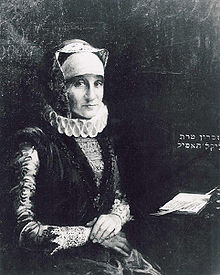Glückel of Hameln
| Glückel of Hameln | |
|---|---|

A fancy portrait of Bertha Pappenheim in the persona of Glückel, wearing 17th century costume. The portrait is painted in a pastiche of the style of the period by Leopold Pilichowski. Pappenheim was a descendant of Glückel, who also translated the diaries into German.
|
|
| Born |
Glikl bas Judah Leib 1646 Hamburg, Holy Roman Empire |
| Died | September 19, 1724 Metz |
| Other names | Glikl bas Judah Leib, Glikl Haml |
| Known for | Jewish businesswoman and diarist |
| Spouse(s) | Hayyim of Hamelin, Cerf Levy |
Glückel of Hameln (also spelled Gluckel, Glueckel, or Glikl of Hamelin; also known as Glikl bas Judah Leib) (1646 – September 19, 1724) was a Jewish businesswoman and diarist, whose account of life provides scholars with an intimate picture of German Jewish communal life in the late-17th-early 18th century Jewish ghetto. It was a time of transition from the authority and autonomy of the Medieval kehilla, toward a more modern ethos in which membership in the community was voluntary and Jewish identity far more personal and existential; a time historian Jacob Katz has defined as 'tradition and crisis',in his 1961 book by that name. Written in Yiddish, her diaries were originally intended for her descendants. The first part is actually a living will urging them to live ethical lives. It was only much later that historians discovered the diaries and began to appreciate her account of life at that time.
Glückel was born in the city of Hamburg in 1646. Her family was expelled, along with the rest of the Ashkenazic Jewish community, in 1649. When she was twelve years old, her parents betrothed her to Hayyim of Hamelin, whom she married in 1660, at the age of 14. After the marriage, the couple lived in his parents’ home in Hamelin. A year after their marriage, the couple moved in with Glückel's parents in Hamburg, where Hayyim became an affluent businessman. Already involved in his business during his lifetime, when he died in 1689, she took over the business, conducting trade with markets as far as Amsterdam, Leipzig, Berlin, Vienna, Metz and Paris.
In 1700 she remarried, to a banker from Metz in Lorraine, and relocated there. Two years later, her husband Cerf Levy failed financially, losing not only his own fortune but hers as well. He died in 1712, leaving her a widow for a second time. She died in Metz in 1724.
...
Wikipedia
